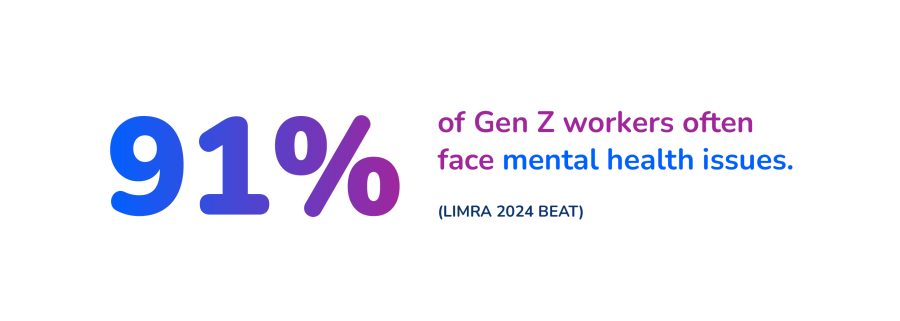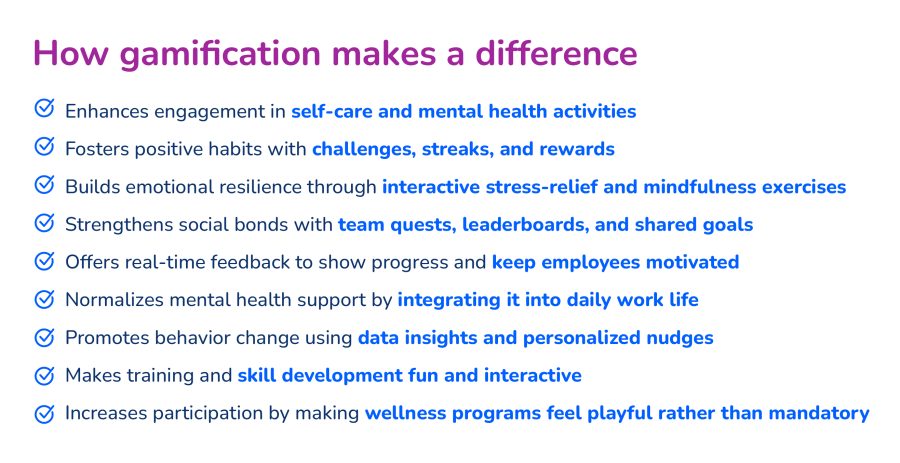Discover how gamification helps boost mental health, reduce stress, and build engagement at work.

Back to Blog
Mental health isn’t something we leave at home. It comes with us into offices, co-working spaces, and Zoom calls. According to the World Health Organization, 12 billion workdays are lost every year due to depression and anxiety, costing businesses more than US $1 trillion in lost productivity.
The American Psychological Association also found that over three-quarters of employees report symptoms of emotional strain, and 84 % believe their job is responsible for that.
Poor mental well-being lowers morale, drains creativity, drives up absenteeism, and hurts retention. Research shows that happier, less anxious employees are also more innovative and productive. Those who receive support for mental health challenges even see an 80 % boost in effectiveness.
Additionally, toxic cultures and chronic stress push talented people away, especially younger generations who openly prioritize mental health.
A study by LIMRA 2024 BEAT, reveals that 91% of Gen Z workers often face mental health issues. With the U.S. Bureau of Labor Statistics projecting that Gen Z will make up about 30% of the american workforce by 2030, businesses risk losing the next generation who will shape the future of work if they don’t act quickly. This generation is known for being very vocal, value-driven, and unafraid to leave workplaces that don’t meet their expectations.
In short, prioritizing mental well‑being isn’t a perk. It’s a smart business strategy.

In recent years, game elements have gained popularity as a creative way to support mental health at work, and well-known examples like Headspace or SuperBetter serve as powerful proof of concept.
Gamification creates a supportive environment by making mental health approachable and engaging. It motivates employees with rewards, progress tracking, and challenges that promote self-awareness, build self-efficacy, strengthen social bonds, and help reduce stress and communication barriers.
Gamified platforms can also provide personalized insights, highlight patterns, and help organizations identify employees who might need extra support while promoting creativity and a better work-life balance.
Gamification is a performance tool, but is also becoming a mental health tool.
We’ve already established the potential that companies could unlock by introducing gamified elements into the workplace. Let’s explore how to actually apply gamification to boost engagement, social bonding, self-awareness, morale, and much more!
Increase motivation and engagement
By incorporating elements like challenges, rewards, and progress tracking, gamification taps into employees’ intrinsic motivation to participate in activities. When mental health activities feel more like a game than an assignment, employees are more likely to engage and complete them successfully.
Encourage healthy habits
Gamified wellness programs can encourage employees to adopt healthier behaviors, such as regular exercise, balanced eating, and mindfulness. Rewards and positive feedback make it easier to build these habits and maintain them over time.
Reduce stress and improve mood
Interactive stress‑relief games and mindfulness challenges help employees manage tension and prevent burnout. The sense of achievement from completing these activities boosts morale. A 2024 review in BMC Public Health even found that gamified interventions significantly improved psychological well-being and reduced depressive symptoms.
Builds a sense of community
Team challenges and social features like leaderboards promote friendly competition and collaboration. This helps break down silos, reduce isolation, and build stronger team connections.
Provide instant feedback and motivation
Gamification provides immediate feedback on progress, allowing employees to see their achievements and stay motivated. The rewards and recognition associated with gamified programs can create a positive feedback loop, reinforcing desired behaviors and encouraging continued participation.
Promote skill‑building
Promoting skill-building through gamification is a powerful strategy for enhancing workplace mental health and overall well-being. By transforming often dry or dull training into interactive and enjoyable experiences, gamified approaches like tailored simulations, such as those for stress-management modules or ergonomics training, make learning engaging.

Gamification can revolutionize workplace mental health by offering engaging and effective ways to support employees’ well-being. It fosters a sense of community, reduces the associated stigma, and encourages open conversations about mental health.
Investing in mental health is essential, not just for employees who spend most of their waking hours at work but also for the organization that relies on them.
At vaibe, we believe that combining proven methods with playful, gamified tools can help companies create vibrant, healthy environments that empower employees and ultimately improve business outcomes.
Are you interested in how we can collaborate to enhance mental health in your organization and turn it into a competitive advantage? Contact us for more details!
Increase teamwork with healthy competition at work using gamification. Discover how it works.
Struggling with disengaged teams, inefficiencies or high turnover?
Discover how gamification transforms challenges into wins!
Learn effective strategies to boost employee engagement, retention, and workplace satisfaction.
Learn how game mechanics, rewards and motivation strategies influence employee engagement.